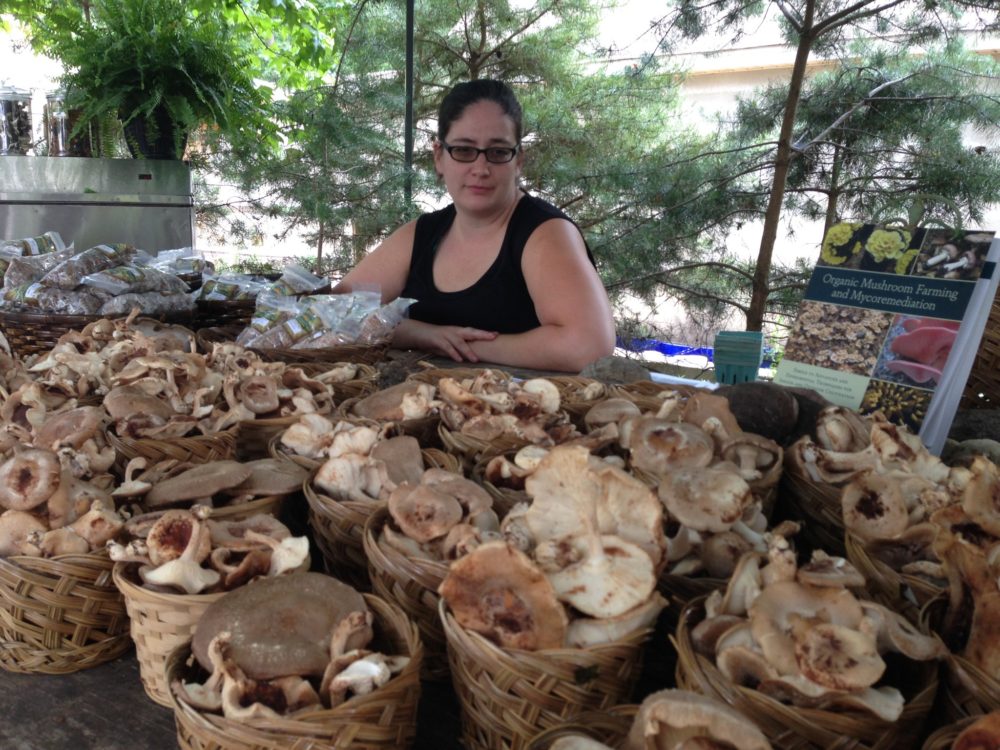By Eric Soderholm, Organic Production Coordinator | Apr. 23, 2014 –

This article is part two of shiitake mushroom production. Don’t miss: Choosing & Preparing Logs for Shiitake Mushroom Production
Let’s take a moment to appreciate the beauty of the (simplified) lifecycle of these choice edibles. Shiitakes, like all mushrooms, produce two spore mating types—the fungal equivalent to sperm and eggs. Once released from the gills of a mature shiitake, spores that find themselves in damp conditions with access to a food supply will germinate and grow to form hyphae. If these developing fibers meet with compatible hyphae of the opposite spore type, they join together to knit the branching fungal mass know as mycelium.
Spawn is the term used to describe living, viable mycelium and the temporary food source on which it is grown before being introduced or “inoculated” in the final growth medium (logs, compressed sawdust, manure, straw, soil etc). In the case of shiitakes, spawn is generally available in two forms for log production: plugs or sawdust. Sawdust spawn is quite often cheaper per log to use and may produce mushrooms more quickly but requires a special inoculation tool (approximately $30 or more to purchase) to insert the spawn. Plug spawn is more tolerant to lower moisture levels and some growers claim they are faster and easier to set— though certainly more costly if you are inoculating 100 or more logs.
Inoculating logs with either type of spawn requires that several rows of holes be drilled along the length of the log, beginning about 1 inch from the ends. Suggested spacing is generally 3-4 inches between rows and 6-8 inches between holes within a row, making a staggered diamond-shaped pattern. The depth and diameter of these holes will depend on the size of the plugs or the inoculating tool required for sawdust spawn. It is advised that you use a corded power drill, a carefully chosen, sharp bit, and a bit stop collar to maintain a uniform drilling depth.
AFTER DRILLING
Once the logs are drilled, plug spawn is tapped in with a hammer and sawdust spawn is packed into the holes with the inoculation tool mentioned above. The open wound should then be sealed with wax to prevent other fungi from colonizing the log and to reduce moisture loss. Wax can be heated on a stovetop or outdoor burner in a double-boiler-type container and applied with a brush or wax dauber. I find that it is best to work with a crew of three or more people with one drilling–one inserting spawn and one applying wax. This increases efficiency and helps cut down on moisture loss during these steps.
AFTER INOCULATION
Once the logs are inoculated, they should be staked in a large pile in a shady place and monitored. The mycelium will begin to “run” and depending on what strain and spawn type you use, you can expect to bring the logs into production anywhere from 6-12 months later. Ideally, the logs will remain fairly moist during this period and during dry spells it will be necessary to irrigate the logs with a hose or sprinkler system as needed. When irrigating, it is best to soak the logs thoroughly for several hours to a full day instead of more frequent, shorter irrigation periods. The appearance of white streaks on the logs’ ends is an indication that the mycelium has successfully begun to colonize the logs.
A Few Sources of Shiitake Mushroom Spawn
- Location: Liberty, SC
- Availability: Three strains of sawdust and plug spawn: cold, warm or wide fruiting temperature range. Also offering a NC wild strain in plugs.
- Notes: Our very own Olga Cotter, 2012 CFSA Young Farmer of the Year! She offers several inspiring workshops in mushroom cultivation during the year, often including our annual Sustainable Ag Conference.
- Location: Olympia, WA
- Availability: One strain of sawdust and plug spawn: wide fruiting temperature range.
- Notes: They offer certified organic sawdust spawn but claim that they cannot certify the plugs. This is Paul Stamets’ company, a highly-regarded mycologist and mushroom preservationist. Check out some of his many books on the subject. He also offers week-long intensives on various topics at his headquarters in Washington.
FIELD AND FOREST PRODUCTS (OG)
- Location: Peshtigo, WI
- Availability: Eleven strains of sawdust and plug spawn—see website for detailed descriptions
- Notes: All spawn is certified organic, and they offer a great diversity of strains that are grown out at the adjoining farm each season.
Are we missing one of your favorite sources? Send us an email and let us know!
For more in-depth discussion of inoculation and moisture monitoring techniques for shiitake logs, check out this excellent guide: Producing Shiitake Mushrooms: A Guide for Small-Scale Outdoor Cultivation on Logs.


